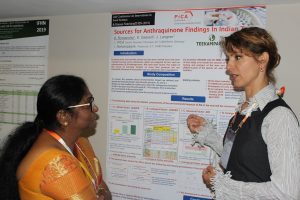
Sources for Nicotine and Anthraquinone in Indian Tea
A. Romanotto, A. Hoffmann, PiCA GmbH Berlin, Germany
K. Gassert, Teekampagne, Potsdam, Germany
K. Speer, Technische Universität, Dresden, Germany
Introduction: In recent years, tea (camelia sensis, camelia assamica) has been viewed more and more critically because the problematic substance anthraquinone (9,10-anthraquinone, AQ) and nicotine (S)-3-(1-methylpyrrolidin-2-y)pyridine, NIC ) have been found in it worldwide.
Both substances, because of their toxic effect on the human organism, are undesirables and are therefore strictly controlled.
The origins of AQ and NIC cannot be precisely located, so in spite of the optimizing and inspection of growth and production processes from planting to packaging, many final products are not marketable.
Composition of the study and methods: The goal of our study is to locate the sources of AQ and NIC on the basis of extensive testing and analysis of the teas and their environment, including different parts of the plants, soil and dust, as well as ferilizers and fortifiers. Altogether we collected more than 300 samples, air, tea leafs, produced teas and samples during the production, soil, water, organic fertilizers during three years.
Methods:
The target substances were measured with GC-MSMS (AQ, PAHs and other oxy PAHs ) and LC-MSMS (NIC and NIC metabolites).
Results:
AQ: with our work, we could prove that AQ is like PAHs a product of burnng of fossil fuels, wood. I is transported by fine dust, what is transported by wind or with mosture masses. Different environmenal factors like distance to the cities, main roads or altitude of the plantation plays an important role. Using of direkt heating produced by burning of coal is the secund important source for AQ in tea. That’s why many tea produceres switsched the heat production from coal burning to gast burning or are using the indirect heating now.
NIC: t is a tobacco production, the biggest tea producing countres of the world like China, India, Indonesia are at the same time the biggest wold producers for tobacco. Tobacco is volitile and also can be transported with air masses and condences
Resumee: In this age of globalization and overproduction, the agriculture industry is faced with more and more environmental problems. The destruction of forests, the growth of garbage dumps, the burning of industrial waste which leads to environmental pollution, are just a few examples. Fine dust and a burning of fossil fuels is the source for AQ in tea.
Research on and the analysis of the agrarian policies of the tea growing countries demonstrate an important correlation between nicotine findings in tea and its neighboring tobacco cultivation.

